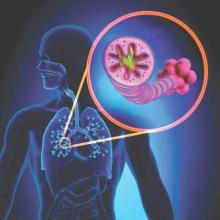LONDON – Improved lung function was seen in patients with chronic obstructive pulmonary disease (COPD) when an inhaled dual phosphodiesterase (PDE) inhibitor, RPL-554, was used on top of standard short-acting treatment in a single-center, crossover study.
There was a 51% increase in the peak forced expiratory volume in 1 second (FEV1) from baseline to the time of measurement up to 12 hours later in patients given RPL-554 in addition to the short-acting beta2-agonist (SABA) salbutamol versus the SABA alone. A benefit also resulted from adding RPL-554 to the short-acting muscarinic antagonist (SAMA) ipratropium. Taking this second combination of drugs resulted in a 66% higher FEV1, when compared with taking the SAMA alone (P less than .001 comparing the combinations with the SABA or SAMA alone).
“We were primarily interested to know if giving this novel drug in addition to a beta-agonist or antimuscarinic could produce more bronchodilation, and that’s what we saw,” said David Singh, MD, of the University of Manchester (England), who presented the study findings at the annual congress of the European Respiratory Society.
In addition to inducing “significant and clinically relevant” additional bronchodilation, a single dose of RPL-554 was found to increase lung volumes when administered on top of standard-of-care bronchodilators. The peak forced vital capacity (FVC) increased by 79.5% when RPL-554 was added to salbutamol and by 43.2% when it was added to ipratropium. There were also improvements in the baseline residual lung volume and in airway conductance.
RPL-554 is a novel inhaled dual PDE-3/4 inhibitor under investigation in the treatment of both COPD and asthmatic patients. “This is a reformulation of RPL-554, delivered by nebulization,” Dr. Singh observed. It has been shown to have both anti-inflammatory and bronchodilatory properties in clinical studies, he added, with the latter action thought to be additive to beta-agonists and synergistic with antimuscarinic agents according to preclinical data.
The aim of the study was to look at the potential additive or synergistic bronchodilatory effects of RPL-554 in a clinical study for patients who had moderate to severe COPD. A total of 36 patients (19 men and 17 women) were recruited; 30 completed the study. The mean age of the recruited patients was 61 years; mean body mass index was 27.7 kg/m2, mean baseline FEV1 was 50.4% or 1.44 L, and the patients exhibited a mean increase in FEV1 of 17.7%, 30 minutes after being given salbutamol or ipratropium at screening. The latter “gives you an idea of the reversibility of the population,” Dr. Singh said.
Six treatment options were compared: salbutamol 200 mcg, salbutamol 200 mcg plus RPL-554 6 mg, ipratropium 40 mcg, ipratropium 40 mcg plus RPL-554 6 mg, RPL-554 6 mg, and placebo. At each treatment visit patients were dosed, in a double-blind fashion, with salbutamol, ipratropium, or placebo via a metered-dose inhaler (MDI), and then randomized to receive either inhaled RPL-554 or a placebo via a nasal nebulizer. Spirometry was performed before and up to 12 hours after treatment, and plethysmography was performed before and at 1 and 4 hours after dosing.
The addition of RPL-554 to standard bronchodilator therapy was associated with a faster onset of bronchodilation when compared to either the SABA or SAMA as monotherapies – at 3.6 minutes when added to salbutamol versus 5.2 minutes for the SABA alone, and 4.2 minutes when added to ipratropium versus 18.4 minutes for the SAMA alone. Used alone, however, RPL-554 had an onset of effect of 14.3 minutes.
Overall, the single-doses of RPL-554 used were well tolerated when given alone or in combination with the other treatments. “Obviously with a PDE-3 inhibitor we want to be careful about cardiovascular changes and monitor that, but we did not see anything,” Dr. Singh reported.
Verona Pharma Plc sponsored the study. Dr. Singh reported receiving sponsorship, honoraria, or research funding from Almirall, AstraZeneca, Boehringer Ingelheim, Chiesi, Genentech, GlaxoSmithKline, Glenmark, Johnson and Johnson, Merck, NAPP, Novartis, Pfizer, Skyepharma, Takeda, Teva, Theravance, and Verona Pharma Plc.


